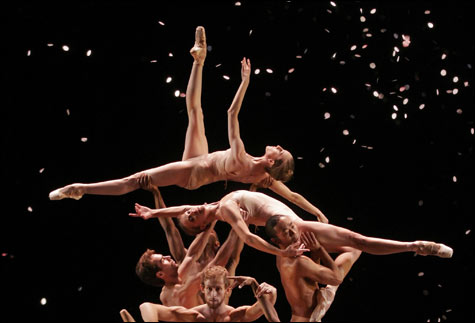
FOOLS’ PARADISE: Wheeldon’s most recent work seemed to merge with everything else on the
program. |
NEW YORK — Starting an independent ballet company is no piece of cake, even if you can assemble a ton of talents to help you. Christopher Wheeldon’s Morphoses made its New York debut last weekend after initial outings in London and Vail, Colorado, with two programs of dances mostly by the 34-year-old English choreographer. If long-term stability could be secured by the warmth and affection that flowed from the City Center stage to the audience and back again, Morphoses would be all set.
The hype was huge, but Wheeldon seems to have a modest agenda. At an open rehearsal Friday afternoon he asked the audience not to think of Morphoses as a “fully formed company.” He’s collected significant start-up funding, tour bookings, and the assurance of performance bases at City Center and Sadler’s Wells Theatre in London. His idea is to build up some shows over the next two or three years — not necessarily with the same dancers — while gradually cultivating the much heftier resources needed to go permanent.
Wheeldon is even more reserved about his artistic vision for the company than he is about its prospects down the line. He describes its mission with an unobjectionable but vague optimism: “to broaden the scope of contemporary classical ballet by marrying dance, music, visual art and design.” Just about anything could fill that frame, and these opening programs didn’t clarify the picture.
Wheeldon has been choreographing for a decade as a prolific and successful freelance. He’s held an important Resident Choreographer appointment at New York City Ballet, and he was Principal Guest Choreographer at Boston Ballet in the late 1990s. Freelancing can give a choreographer great exposure, but it’s more conducive to making miscellaneous, short-lived pieces than creating a durable repertory. Only a few of his ballets have made a lasting impact on our thinking, though I’ve often been impressed with his fidelity to the classical language, his musical good taste, and his gifts as a poet of theatrical dance.
Program building is one skill he hasn’t yet mastered. Each performance had six items, interspersed with bits of atmospheric rehearsal footage filmed by Michael Nunn and William Trevitt (of London’s Ballet Boyz), who were also dancing with Morphoses. Choreographer friends were generous with their works; stellar dancers made appearances. Most of the music was played live by the Orchestra of St. Luke’s conducted by Rob Fisher. Both performances I saw had the feeling of galas, when you relinquish any expectation of a new masterwork as one special thing follows another, making only a momentary claim on your enthusiasm.
The season was heavy on duets, that contemporary kind where the woman gets hauled around by the man, and there were several selections boasting newly invented contortionist effects for two or three men at a time hauling the woman around. My tolerance for this kind of acrobatic sex play is much lower than the rest of the audience’s appears to be. Wheeldon has an advantage over other purveyors of this trendy stuff in that his dance is always grounded in the classical vocabulary. His movement doesn’t look like poses randomly pieced together from here and there. Still, his most recent work, Fools’ Paradise, merges with everything else on the program in my memory, with its duets, serial partnerships, and collective but deliberately not unison activity.